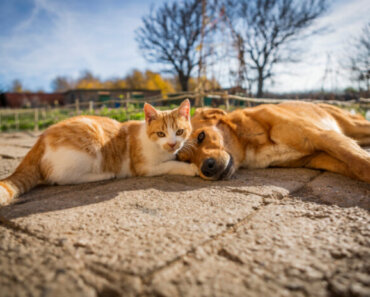We already know that climate change is having an impact on humans and wildlife around the world – but it’s also affecting our dogs and cats. Find out how, and how you can help your four-legged friend adapt.
Despite some naysayers, science has proven that climate change is a fact. We can see its effects every day, in the form of unprecedented floods, wildfires, temperature extremes and more. What we may not see as clearly is how climate change is also affecting our dogs and cats. This article looks at several key areas in which climate change is impacting our animal companions, and what we need to know and do in order to protect their health and safety.
Be prepared for natural disasters
Nowadays, not a season goes by when we don’t experience or hear about a major flood, wildfire, super storm or other extreme weather event. Unfortunately, these natural disasters are expected to grow in power and frequency as climate change worsens. This means it’s vitally important to have an emergency plan in place, not only for your human family, but also for your dog or cat. This is especially the case if you live in a region prone to these events — but you still should have a disaster plan in place even if you live in a relatively untouched area.
An emergency preparedness kit for your dog or cat should include several days of food and water, along with bowls, any medication or supplements he needs, up-to-date ID, a crate or carrier, leash, bedding, and a litter box and litter for your cat. It’s also a good idea to include an envelope containing pics of you and your animal, a copy of your veterinary records, and emergency contact phone numbers – seal this envelope in a waterproof plastic bag. Keep your animal’s emergency kit along with your own in an easy-to-access spot, so that you can grab it in a hurry if you need to evacuate with your animal.
Never leave your dog or cat behind in the event of an evacuation, even if you think you’ll be home again in a few hours. Always err on the side of caution and take him with you.
Protect him from extreme temperatures
From polar vortices to scorching heat waves, temperature extremes are becoming the norm in many parts of the world. This means keeping abreast of the weather forecast to protect your dog or cat from the cold or heat.
- During summer heat waves, keep your animal indoors as much as possible. If you have a dog, walk him during the early morning or evening hours, when the sun is lower and it’s a bit cooler, and keep walks short. Inside the house, use air conditioning if you have it, or plug in a few fans to help keep your animal cool. Make sure he has 24/7 access to clean fresh water.
- During extreme winter cold snaps, when the mercury plunges well below zero, don’t let your animal spend more than a few minutes outside. He could get frostbite very quickly, especially if there’s a strong wind chill. Keep him inside where it’s warm. Supervise your dog when you let him out for potty breaks, and protect him from the cold with booties and a warm doggy coat. If you have a cat, do your best to discourage him from roaming outdoors during periods of extreme cold. Distract him with a new toy or scratching post, or find an app or DVD that’s designed specifically for cats – if he can stalk birds or insects on a screen, he’ll be less likely to want to go out to do it.
Help him adapt to a longer allergy season
Climate Central, an organization of scientists and journalists researching and reporting the facts about our changing climate, has found that the growing season – the period between the last winter freeze and the first fall freeze — has lengthened in over 80% of American cities analyzed.
This longer growing season leads to more pollen and an extended allergy season for both people and their animals. When combined with milder winters, it also means your dog or cat is exposed to fleas for a longer period – if not all year round, depending on where you live.

Look out for ticks
Scientists have reported an increase in ticks and tick-borne diseases, not just in humans, but in companion animals as well. Regions that have been experiencing warmer-than-normal winters in recent years, such as southern Ontario in Canada, have seen an astronomical increase in tick populations, and a significant rise in Lyme disease cases.
This means you need to take extra steps to protect your animal (as well as yourself) from tick bites and Lyme. Keep your dog or cat away from long grasses and overgrown areas, and don’t let your lawn grow too long. When out hiking, keep your dog on the trail, and use natural insect repellents to keep the bugs off. You might even look into a bodysuit designed to protect your dog creepy-crawlies, including ticks and fleas.
There’s no getting around the fact that climate change is real, and that it’s making measurable changes to our world. But by paying attention to what’s happening, and taking steps to adapt to the shifts taking place in our own communities, we can help ourselves – and our dogs and cats – weather the storm.




























